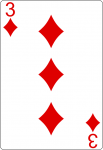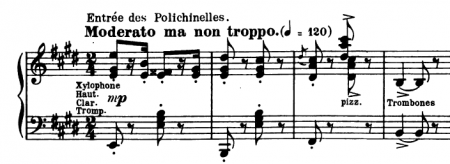
Click here to download the score of Diable à Quatre male variation or click the score above. There’s the full solo (pages 1-2) then on page 3, an adaptation for class – it’s not entirely even, and there’s a lot of waffle at the end.
See here for more about my “A year of Ballet Playing Cards”
One of my “ballet problems” is finding a big two for allegro: music for those medium/big allegros in 2/4 like sissonnes (see previous post on the “dreaded 2/4 sissonne“). I suppose the canonical version is the male “Black Swan” variation. In this post I’ve solved two problems at once – I’ve found a piece of music that does exactly what I want, and settled something (in part, at least) that’s been nagging at me for over a decade.
The search for Diable à quatre
It’s about 14 years ago that I got a phone call from Dance Books in the middle of a summer afternoon, saying that they’d got Yosvani Ramos in the shop: he wanted to know if they’d got the music to Diable à Quatre. They didn’t, so they put him on the phone to me. I was so pleased to be asked, and so wanted to help, but I couldn’t. It’s bugged me ever since, because it ought to be out there somewhere, but it doesn’t seem to be, even though I’ve been checking all the sources I can think of.
So, like the Black Swan solo issue, if you want something done, do it yourself: I set about finding a youtube clip, and transcribed the male solo – both in deference to Yosvani since he put me onto the idea in the first place, and because it’s the right kind of music. What’s really good fun about having stuff like this in your repertoire is to play it for class, and see who recognises it. For me, there’s nothing so gratifying as when someone turns round and says “Oh that’s such and such a piece, isn’t it?” when you’ve played one of your favourite ballet musical shibboleths.
You can see a version of the solo in the clip below – it starts at 8.40 – but it should start there automatically if you click on the video. If you know who the dancer is in the clip, let me know (or put it in the comments on Youtube).
Other examples of the big two for allegro
I’ve found it hard not to mix this up with one of Medora’s solos in Le Corsaire (not one of those that’s in the ENB production, but it’s in the Corsaire piano score at IMLSP, on page 20, in A flat). It’s in the same kind of tempo and style, but it also has the same way of starting with a dotted rhythm, and finishing up in a scale of triplets:

Then that got me thinking that the rhythm of the first line is almost identical to the Polichinelles music in Drigo’s Les Millions d’Arlequin (Harlequinada) on page 80 (No. 11). Put these three solos (Corsaire, Harlequinada and Diable à Quatre) and you can begin to see a model emerging.
Here’s a clip from that section of Harlequinada performed at the Whitehouse in 1979 (starts at 4:41 if the clip doesn’t start there automatically).
Recordings of Diable à quatre
If you want a recording, hurry: as of today there are only three second-hand ones left at Amazon.co.uk (at £6.96). It was recorded by Richard Bonynge and the LSO, but this album wasn’t included in the Decca 10-CD re-release.



